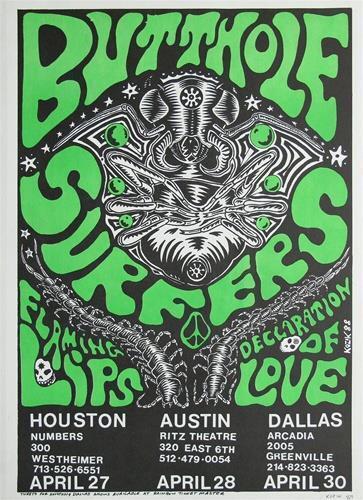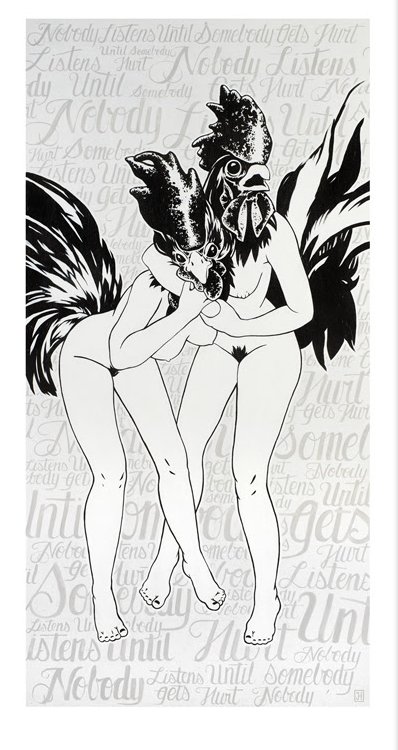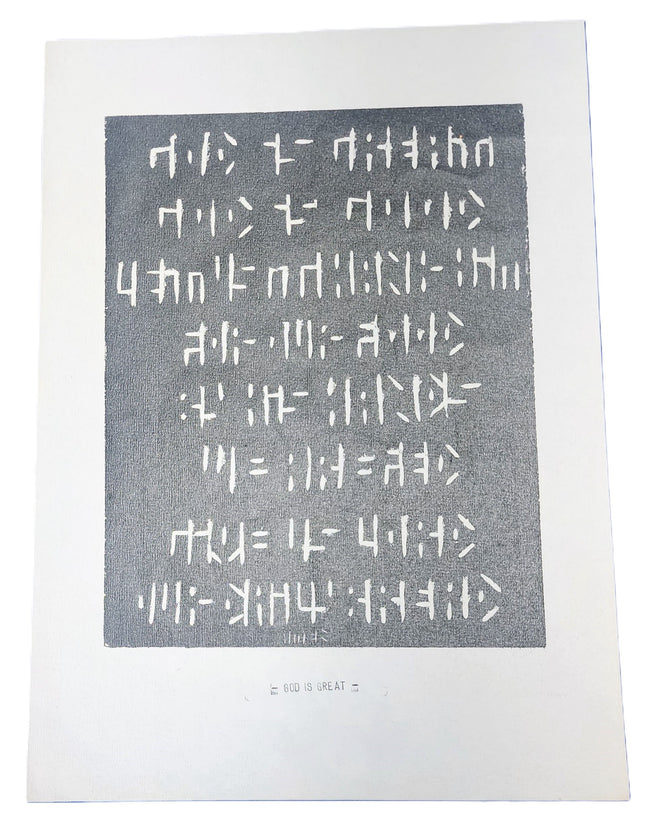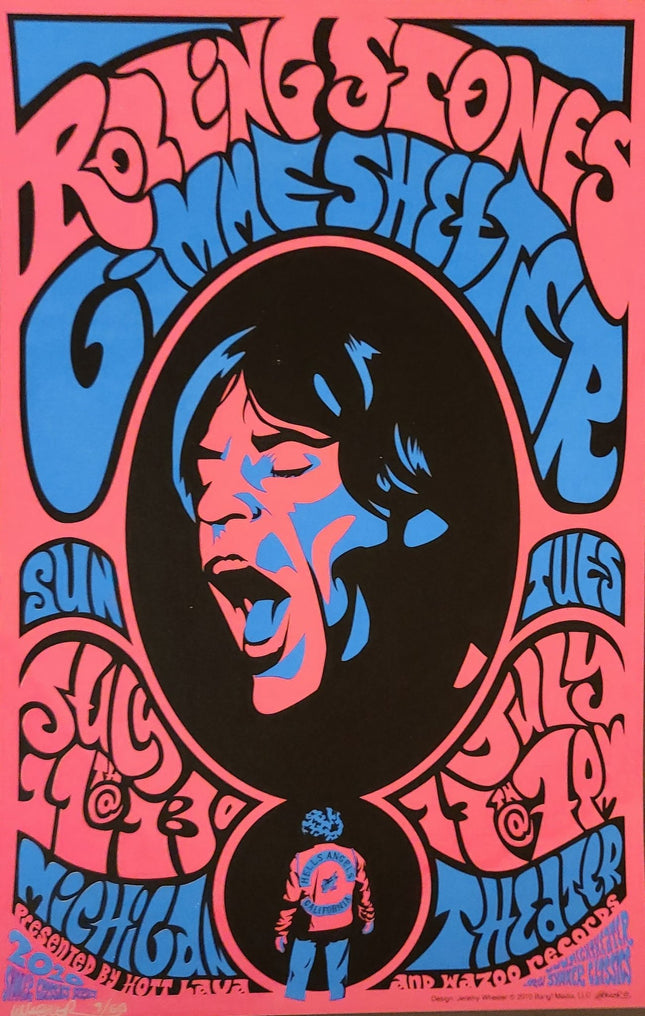
Text Type Words & Sayings

Frank Kozik Butthole Surfers 1989 Houston Austin Dallas Texas Handbill Silkscreen Print by Frank Kozik
Butthole Surfers 1989 Houston Austin Dallas Texas Handbill Silkscreen Print by Frank Kozik Hand-Pulled on Fine Art Paper Limited Edition Pop Street Art Artwork. 1989 Signed by Kozik Music Concert Handbill Artwork Size 11x17 Silkscreen Print Band Gig Poster by Frank Kozik in Texas April 27 28 30 1989 With Flaming Lips & Deccaration Of Love "Butthole Surfers x Frank Kozik" represents an iconic collaboration between the audacious rock band, Butthole Surfers, and acclaimed graphic artist, Frank Kozik. Known for their experimental, often outlandish sound, Butthole Surfers have made a name for themselves in the alternative rock scene. On the other hand, Kozik has been influential in revitalizing the concert poster art scene, and his designs are coveted for their distinctive, vivid style. This partnership brings together the edgy, anarchic spirit of the band with Kozik's striking visual aesthetics, creating a truly unique blend of sound and imagery that promises to be a feast for the senses.
$247.00

Jessica Hess Cock Fight Archival Print by Jessica Hess
Cock Fight Archival Print by Jessica Hess Limited Edition Print on Moab Fine Art Paper Pop Artist Modern Artwork. Signed & Numbered Limited Edition of 50 Artwork Size 9x17 Archival Pigment Fine Art
$141.00

Other Artists God Is Great Script Woodblock Print by Unknown
God Is Great Script Woodblock Print by Unknown Hand-Pulled on Textured Fine Art Paper Limited Edition Artwork. 2008 Limited Edition Woodblock Woodcut Block Print Artwork Size 12x17 of Black & White Fictional Script Words from a St Louis Artist I Forgot the Name of. The Eloquent Silence of "God Is Great" Woodblock Print In visual art, few mediums speak as poignantly to the union of the ancient and the avant-garde as woodblock printing. The "God Is Great" woodblock print, a limited edition piece crafted in 2008, exemplifies the enduring relevance of this time-honored technique in modern artistic discourse. Although the creator from St. Louis remains unnamed, the artwork itself—a stark interplay of black and white fictional script on a textured fine art paper, size 12x17 inches—communicates a universal message that transcends the need for authorial identity. Woodblock Printing: A Dialogue Across Time Woodblock printing, one of the oldest methods of printmaking, has a storied history that stretches from ancient East Asia to contemporary art studios around the globe. The method involves carving an image into the surface of a block of wood, inking the surface, and then pressing it onto paper or fabric to create an impression. With its bold script and abstract composition, this particular piece reflects the technique's robust potential for precision and expression. The black and white color scheme of "God Is Great" reinforces the timeless nature of the print. At the same time, the enigmatic script suggests a language beyond words, an attempt to capture the inexpressible. With its minimalistic yet profound impact, this aesthetic finds echoes in the visual strategies of street pop art and graffiti, where the message is often condensed into symbols or stylized text that resonates with viewers on an instinctual level. Cultural Resonance in Contemporary Art "God Is Great" stands as an artifact of cultural resonance, embodying the essence of what many street artists and pop art practitioners aim to achieve—a piece that is accessible yet profound, immediate yet enduring. It prompts viewers to ponder the power of language, the act of communication, and the possibility of divine presence in the mundane. Despite the anonymity of its creator, the print carries a weight that speaks to the shared human quest for understanding and connection. This woodblock print's presence within pop art, street art, and graffiti is a testament to the fluid boundaries of art forms and the shared visual language that unites disparate genres. While the origin of "God Is Great" may be shrouded in mystery, the work becomes a vessel for contemplation and dialogue, inviting interpretation and engagement from those who encounter it. The "God Is Great" woodblock print, even without the renown of a known artist's signature, is a compelling testament to the power of traditional printmaking techniques in the contemporary artistic landscape. It reminds us that art, in its purest form, is a dialogue that spans history, transcends barriers, and continues to evolve, inviting each viewer to partake in its ongoing narrative.
$100.00

Jeremy Wheeler Gimme Shelter Michigan Theater 2010 Pink Silkscreen Print by Jeremy Wheeler
Gimme Shelter- Michigan Theater 2010- Pink Music Limited Edition Gig Poster 2-Color Hand-Pulled Silkscreen Print Artwork on Pink Fine Art Paper by Jeremy Wheeler for Rolling Stones. Pink Variant, July 11th and 13th 2010 Michigan Theater Rock N Roll Music Show with Rolling Stones by Hott Lava and Wazoo Records.
$153.00





